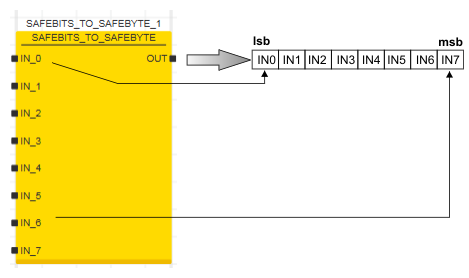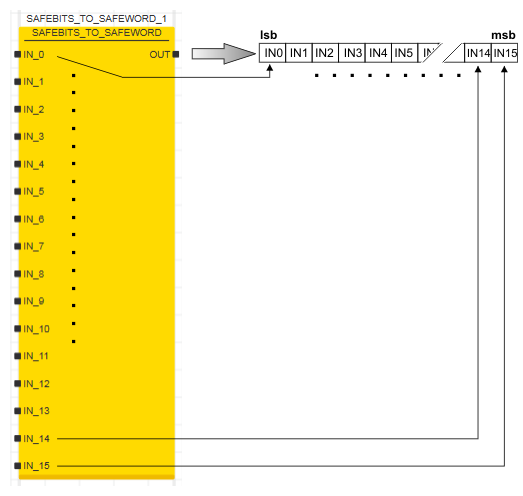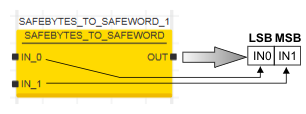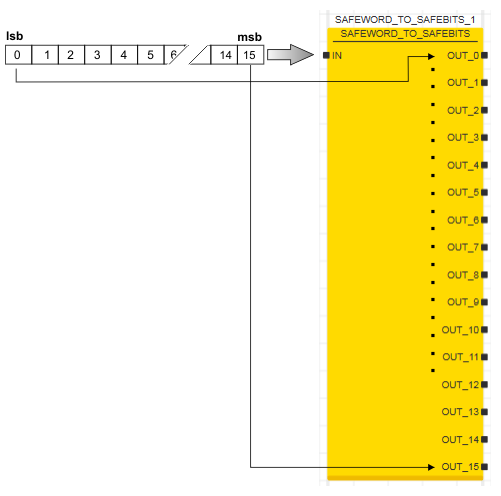|
Type
| Function blocksAvailable as standard (non-safety-related) and safety-related type (*_S). For the safety-related type, the safety-related data types (SAFE*) are expected at the formal parameters. |
|
Description
| The assembling function blocks are used to summarize binary signals to bit groups consisting of 8, 16, or 32 bits. To access the individual bits (BOOL) in a bit group, the group (BYTE, WORD, or DWORD) has to be split first using the splitting function blocks.
Background: To improve the clarity of the safety logic and to process signals as a bundle, the individual binary signals (BOOLean variables) can be combined (summarized) to groups. These bit groups can then be handled as BYTE, WORD, or DWORD data type respectively. |
|
Available function blocks
| Assembly function blocks:
 SAFEBITS_TO_SAFEBYTE / BITS_TO_BYTE SAFEBITS_TO_SAFEBYTE / BITS_TO_BYTE
| Description: | Summarizes
eight (SAFE)BOOL input variables to one (SAFE)BYTE output variable. |
| Bit valence: | In the output BYTE, the bit read at IN_0 is inserted as least significant bit (lsb) as shown below. IN_7 is considered as most significant bit (msb). |
| 1 | 
Note
The same bit allocation also applies to the corresponding standard function block. |
|
 SAFEBITS_TO_SAFEWORD / BITS_TO_WORD SAFEBITS_TO_SAFEWORD / BITS_TO_WORD
| Description: | Summarizes 16 (SAFE)BOOL input variables to one (SAFE)WORD output variable.
|
| Bit valence: | In the output WORD, the bit read at IN_0 is inserted as least significant bit (lsb) as shown below. IN_15 is considered as most significant bit (msb). |
| 1 | 
Note
The same bit allocation also applies to the corresponding standard function block. |
|
 SAFEBYTES_TO_SAFEWORD / BYTES_TO_WORD SAFEBYTES_TO_SAFEWORD / BYTES_TO_WORD
| Description: | Summarizes two (SAFE)BYTE input variables to one (SAFE)WORD output variable. |
| Bit valence: | In the output WORD, the BYTE read at IN_0 is inserted as least significant BYTE (lsb) as shown below. IN_1 is considered as most significant BYTE (msb). |
| 1 | 
Note
The same bit allocation also applies to the corresponding standard function block. |
|
 SAFEWORDS_TO_SAFEDWORD / WORDS_TO_DWORD SAFEWORDS_TO_SAFEDWORD / WORDS_TO_DWORD
| Description: | Summarizes two (SAFE)WORD input variables to one (SAFE)DWORD output variable. |
| Bit valence: | In the output DWORD, the WORD read at IN_0 is inserted as least significant WORD (lsw). IN_1 is inserted as most significant WORD (msw). |
| 1 | 
Note
The same bit allocation also applies to the corresponding standard function block. |
|
Splitting function blocks:
 SAFEBYTE_TO_SAFEBITS / BYTE_TO_BITS SAFEBYTE_TO_SAFEBITS / BYTE_TO_BITS
| Description: | Splits one (SAFE)BYTE input variable to
eight (SAFE)BOOL output variables. |
| Bit valence: | The least significant bit (lsb), i.e., bit 0 of the input BYTE, is applied to output OUT_0. The most significant bit (msb) of the input BYTE is output at OUT_7. |
| 1 | 
Note
The same bit allocation also applies to the corresponding standard function block. |
|
 SAFEWORD_TO_SAFEBITS / WORD_TO_BITS SAFEWORD_TO_SAFEBITS / WORD_TO_BITS
| Description: | Splits one (SAFE)WORD input variable to 16 (SAFE)BOOL output variables. |
| Bit valence: | The least significant bit (lsb), i.e., bit 0 of the input WORD, is applied to output OUT_0. The most significant bit (msb) of the input WORD is output at OUT_15. |
| 1 | 
Note
The same bit allocation also applies to the corresponding standard function block. |
|
 SAFEWORD_TO_SAFEBYTES / WORD_TO_BYTES SAFEWORD_TO_SAFEBYTES / WORD_TO_BYTES
| Description: | Splits one (SAFE)WORD input variable to
two (SAFE)BYTE output variables. |
| Bit valence: | Bits 0 to 7 of the input WORD are output as BYTE variable at OUT_0. Bits 8 to 15 of the input WORD are output as BYTE variable at OUT_1. |
| 1 | 
Note
The same bit allocation also applies to the corresponding standard function block. |
|
 SAFEDWORD_TO_SAFEWORDS / DWORD_TO_WORDS SAFEDWORD_TO_SAFEWORDS / DWORD_TO_WORDS
| Description: | Splits one (SAFE)DWORD input variable to
two (SAFE)WORD output variables. |
| Bit valence: | Bits 0 to 15 of the input DWORD are output as WORD variable at OUT_0. Bits 16 to 31 of the input DWORD are output as WORD variable at OUT_1. |
| 1 | 
Note
The same bit allocation also applies to the corresponding standard function block. |
|
|
 SAFEBITS_TO_SAFEBYTE / BITS_TO_BYTE
SAFEBITS_TO_SAFEBYTE / BITS_TO_BYTE
 SAFEBITS_TO_SAFEWORD / BITS_TO_WORD
SAFEBITS_TO_SAFEWORD / BITS_TO_WORD
 SAFEBYTES_TO_SAFEWORD / BYTES_TO_WORD
SAFEBYTES_TO_SAFEWORD / BYTES_TO_WORD
 SAFEWORDS_TO_SAFEDWORD / WORDS_TO_DWORD
Splitting function blocks:
SAFEWORDS_TO_SAFEDWORD / WORDS_TO_DWORD
Splitting function blocks:
 SAFEBYTE_TO_SAFEBITS / BYTE_TO_BITS
SAFEBYTE_TO_SAFEBITS / BYTE_TO_BITS
 SAFEWORD_TO_SAFEBITS / WORD_TO_BITS
SAFEWORD_TO_SAFEBITS / WORD_TO_BITS
 SAFEWORD_TO_SAFEBYTES / WORD_TO_BYTES
SAFEWORD_TO_SAFEBYTES / WORD_TO_BYTES
 SAFEDWORD_TO_SAFEWORDS / DWORD_TO_WORDS
SAFEDWORD_TO_SAFEWORDS / DWORD_TO_WORDS







